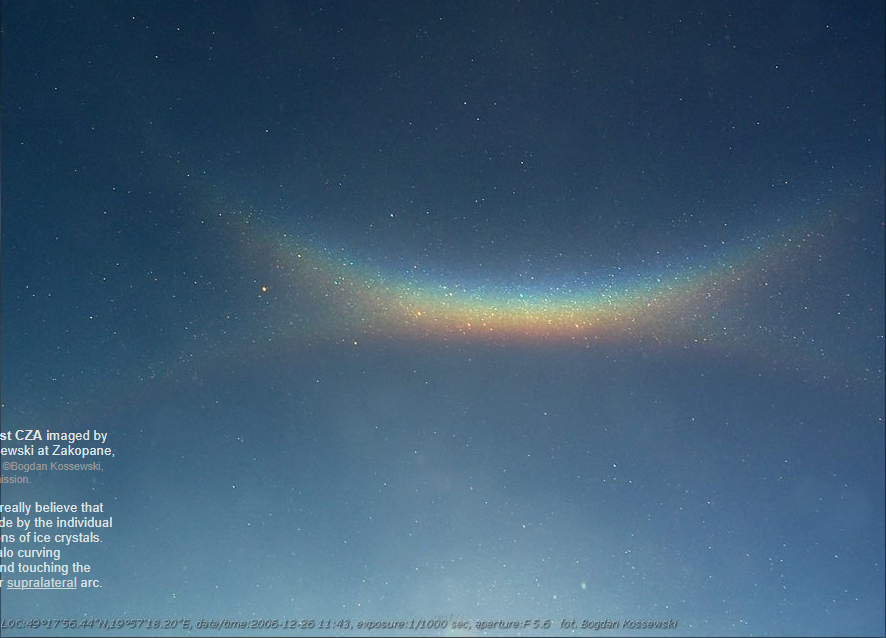Circumzenithal Arc, Poland
Circumzenithal Arc, Poland: A Spectacular Atmospheric Phenomenon
Have you ever looked up at the sky and witnessed a breathtaking display of colors and arcs? One such captivating atmospheric phenomenon is the Circumzenithal Arc (CZA). In this article, we will delve into the beauty and science behind this optical wonder, specifically exploring its occurrence in Poland.
Understanding the Circumzenithal Arc
The Circumzenithal Arc is a rare and mesmerizing optical phenomenon that occurs when sunlight interacts with ice crystals in the atmosphere. It forms a vibrant arc that appears like an upside-down rainbow, curving upwards from the horizon. Often referred to as the "smile in the sky," the CZA is known for its vivid colors and ethereal beauty.
The Science Behind the CZA
To understand how the Circumzenithal Arc is formed, we must delve into the science of atmospheric optics. When sunlight enters the atmosphere, it encounters ice crystals suspended in the air. These hexagonal ice crystals act as tiny prisms, refracting and reflecting light in various directions. As sunlight passes through these ice crystals, it undergoes multiple internal reflections and refractions, leading to the formation of the CZA.
The Role of Ice Crystals
The shape and orientation of ice crystals play a crucial role in the formation of the Circumzenithal Arc. Ideally, the crystals need to be plate-like or column-like with flat surfaces parallel to the ground. This specific geometry allows sunlight to enter through one side of the crystal, refract internally, and exit through another side. The angle at which sunlight enters and exits the crystal determines the position and curvature of the CZA.
Capturing the CZA in Poland
Poland, with its cold winters and frequent snowfall, provides an ideal environment for the formation of ice crystals necessary for the Circumzenithal Arc. The country's picturesque landscapes become even more enchanting when adorned with this optical phenomenon. One such remarkable image of the CZA was captured by Bogdan Kossewski in Zakopane, Poland. The image showcases the intricate details of the arc and its interaction with a supralateral arc, creating a truly extraordinary sight.
The Supralateral Arc
In addition to the Circumzenithal Arc, Kossewski's image also captures a fainter halo curving downwards and touching the CZA. This secondary arc is known as a supralateral arc and is even rarer than the CZA itself. The supralateral arc forms when sunlight enters the ice crystals at a different angle, resulting in a distinct curvature below the Circumzenithal Arc.
Appreciating Nature's Artistry
The Circumzenithal Arc, with its vibrant colors and graceful curvature, serves as a reminder of the wonders that nature can create. It is a testament to the intricate processes occurring in our atmosphere and the beauty that can emerge from them. Witnessing such an awe-inspiring phenomenon in Poland is a testament to the country's natural splendor and offers a unique opportunity for photographers and nature enthusiasts to capture its magic.
Conclusion
The Circumzenithal Arc is a captivating atmospheric phenomenon that never fails to leave observers in awe. Its occurrence in Poland, particularly in locations like Zakopane, adds an extra layer of beauty to the country's already stunning landscapes. The interplay between sunlight and ice crystals creates a spectacle that is both scientifically intriguing and visually stunning. So, the next time you find yourself gazing at the sky, keep an eye out for the elusive Circumzenithal Arc and let yourself be enchanted by its ethereal charm.

Diamond Dust CZA imaged by Bogdan Kossewski at Zakopane, Poland.
Image ©Bogdan Kossewski, shown with permission.
Here we can really believe that halos are made by the individual glints of millions of ice crystals. The fainter halo curving downwards and touching the CZA is a rarer supralateral arc.
Note: this article has been automatically converted from the old site and may not appear as intended. You can find the original article here.
Reference Atmospheric Optics
If you use any of the definitions, information, or data presented on Atmospheric Optics, please copy the link or reference below to properly credit us as the reference source. Thank you!
-
<a href="https://atoptics.co.uk/blog/circumzenithal-arc-poland/">Circumzenithal Arc, Poland</a>
-
"Circumzenithal Arc, Poland". Atmospheric Optics. Accessed on April 20, 2024. https://atoptics.co.uk/blog/circumzenithal-arc-poland/.
-
"Circumzenithal Arc, Poland". Atmospheric Optics, https://atoptics.co.uk/blog/circumzenithal-arc-poland/. Accessed 20 April, 2024
-
Circumzenithal Arc, Poland. Atmospheric Optics. Retrieved from https://atoptics.co.uk/blog/circumzenithal-arc-poland/.